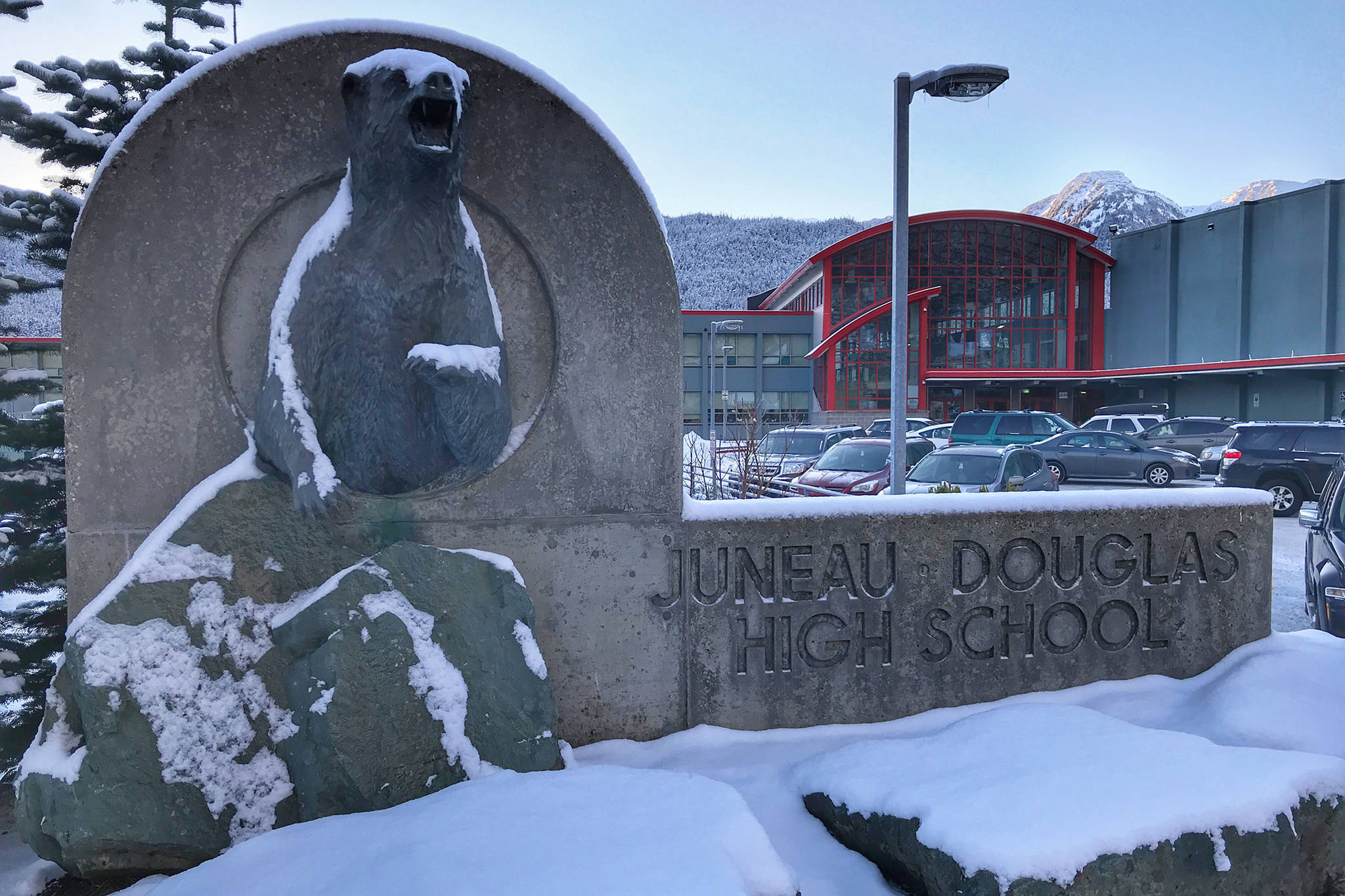Students learn about themselves and shape their identities in high school. But in this case, it’s the school itself that is embracing a new identity.
After a yearlong student-led effort and hearing many emotional public testimonies, the school board voted unanimously to adopt a gifted name addition for Juneau-Douglas High School.
Its new name is the same of the mountain that towers above it: Yadaa.at Kalé, meaning “beautifully adorned face” in the Tlingit language. The official name Juneau-Douglas Yadaa.at Kalé High School honors past and present occupancy of the tribes in the school area.
The decision received a standing ovation from the audience of about 50 people at Tuesday night’s school board meeting.
“As a former educator at JDHS, a student and a mother and grandmother of children who attended school here, there is a sense of great satisfaction,” said Barbara Cadiente-Nelson, who is the Indian Studies program director for the Juneau School District. “Even that word isn’t the right word that sums up my feelings about this name change.”
Changing a school’s name is a bureaucratic process. The initiative started in Henry Hopkin’s science class. Hopkins always pointed out the indigenous place names, and his students began to take notice as to why other schools had Tlingit names, but JDHS didn’t. Students became particularly interested in the idea last year, Hopkins said, when the Tlingit name Sayéik (Spirit Helper) was added to Gastineau Community School.
[Students working to add name to Juneau-Douglas High School]
“I’ve seen Tlingit culture grow at take root at JDHS,” Hopkins said. “I have made a point as a teacher (over the last 20 years) to make it visible.”
One student, senior Arias Hoyle, led the charge. He and other students gathered signatures from about 70 students in support, met with student council, the Douglas Indian Association and the school’s site council to figure out how to make the change happen. Hoyle said it was one thing to just talk about an idea. He wanted to execute it.
“This is the opportunity for our school to finally be embraced in Alaska Native culture,” Hoyle said. “All of my elders have gone to this school. And this time we actually get to see a Tlingit name on a building and embrace who we are and make future generations comfortable and welcome them in.”
The process of considering names was a joint effort among DIA board members, who are members of both the Auk’w Kwaan and Taku Kwaan. The school rests on land that originally belonged to the Auk’w Kwaan people. With permission from the Auk’w Kwaan tribal leader Rosa Miller, Miller’s daughter Fran Houston said she agreed to gift the name to the students. Houston said she would like to see more of the Juneau schools given Tlingit names to provide unity in the schools at last month’s school board meeting.
Cadiente-Nelson said adding the Alaska Native name officially also contributes to a process of healing for the community. In 1956, the city paved over a Tlingit burial ground to build a highway and a school. In 1962, the city of Douglas burned down the Douglas Indian Village to make way for Douglas harbor.
When Sayéik Gastineau Community School was being renovated in 2012, contractors inadvertently unearthed five graves. Since then, the City and Borough of Juneau has worked with the DIA to acknowledge the past and to try to heal the deep wounds that were caused by previous events.
“After the unearthing of the burial ground, University of Alaska Southeast Anthropologist Daniel Monteith asked how do we move forward as a community to heal,” Cadiente-Nelson said. “Perhaps we begin by restoring indigenous place names. There is a great sense of healing occurring and this is a significant one.”
[Group talks about path to healing over village burned decades ago]
David Katzeek, Tlingit elder and JDHS class of 1962 alumnus, said the Tlingit people have been giving names to places for over 10,000 years because they are loved and there are memories about the place. But it’s only a step in the healing process. The rest is a mindset of humility and kindness. And the gifting of this name is the Tlingit people living what they believe.
“I’m going to tell my grandchildren: look at the quality of our people,” Katzeek said. “Instead of beating up on anybody with words, we gave a gift. That talks about the quality and the character of human beings, which is more powerful than any form of achievement in the educational world. It enhances a good education.”
Katie McKenna, the JDHS student representative for the school board, said when she mentioned the name change in passing to other students, they all seemed in support of the move and that it’s a good way to learn the history of the place where they live.
“I think it’s started a fire inside kids to know that they really can take action like this and that there are staff members that are willing to help them, and help them figure out the process if there hasn’t been a pathway that’s already set,” she said.
While the official name change is immediate, some visible changes might take a bit longer to implement. Cadiente-Nelson said zero-cost changes would happen as soon as possible, such as changing the website and digital banners. But as for replacing signs and letterheads, she wasn’t sure when they would happen because the school district is already tight for funds.
“It raises my chin up to know that the work has been great and deep and pervasive and transformational,” Cadiente-Nelson said. “At the very essence of our work is that all children would be proud of their connection to this place, proud of their identity to this place — Native and non-Native, proud to say that this is my school, proud to say that we are a community of one.”
• Contact reporter Mollie Barnes at 523-2228 or mbarnes@juneauempire.com.

